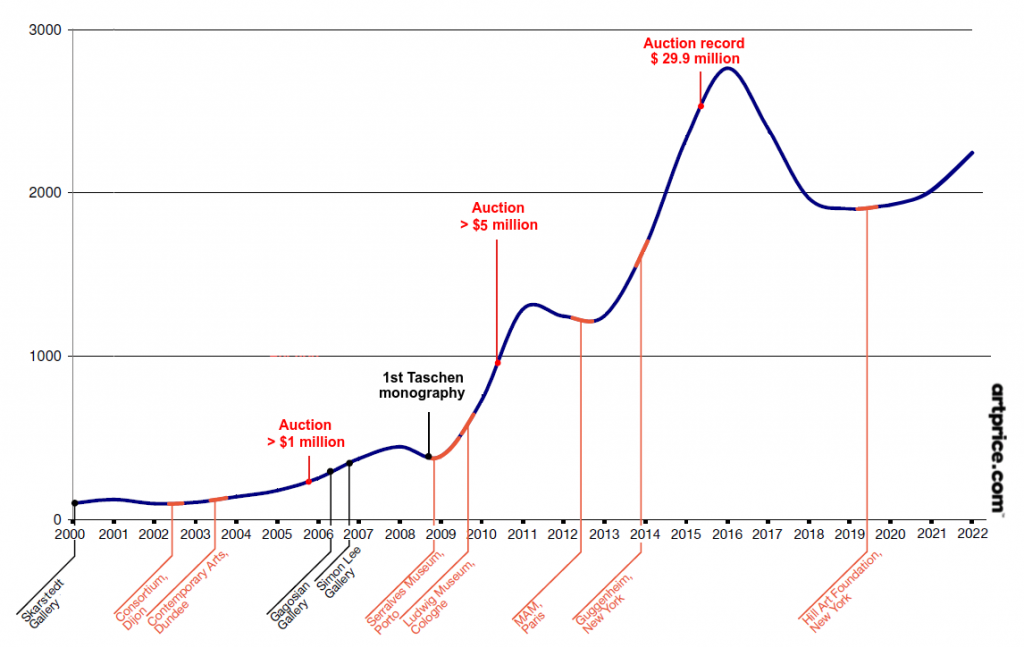The Artprice100© index up +36% in 2021
[07/07/2022]Art is now widely considered an alternative investment that not only offers high returns but also a relatively low correlation to other financial assets. Investing in the greatest artists (such as Pablo Picasso, Claude Monet, or Georgia O’Keeffe) can therefore be a matter of personal satisfaction and financial advantage – as long as we take into consideration certain art market specificities such as the timeframes for selling unique works and the considerable associated costs.
Artmarket.com: the Artprice 100© index up +36% in 2021

Thierry Ehrmann, CEO, and Founder of Artmarket.com: “We are very proud to have played a leading role for 25 years, with Artprice, in the process of democratizing the art market. Restricted to an elite group of connoisseurs until the end of the 20th century, the art market is now accessssible to a much larger number of people. Our services offer affordable information that can be consulted anywhere, without limit and it is updated every hour. With our value-added data, art professionals and enthusiasts can buy and sell exceptional and family works with complete peace of mind”.
Frequently, it seems, the Art World is shaken by a sensational story. From the discovery of a Turner in the bric-a-brac of a garage sale to the sudden increase in value of a self-destructing Banksy at the end of its sale… there appears to be many different ways to make a substantial profit on the art market. But in reality, these sensational stories remain exceptional, and for each of them, tens of thousands of works change hands every year in a much more discreet and reasonable manner.
Reducing uncertainty
Risk, in the financial sense, is an integral part of any form of investment, and art is no exception to this rule; indeed quite the contrary. Fortunately, this risk can be partly controlled in several ways, notably by knowing how to recognize the value of a work and by buying at the best price.
The buyer who dared to acquire Christopher Wool’s Untitled (1990) in 2000 for $35,250, completed an extraordinary operation by reselling it fifteen years later for $2,405,000. Nevertheless, that investment involved significant financial risks linked to a high level of uncertainty. The value accretion of works by Christopher Wool essentially began after the financial crisis of 2008, as revealed by the price index calculated by Artprice for original works by this artist. In fact, a collector who bought a canvas (or a drawing) by Christopher Wool just after he joined the Gagosian and Simon Lee galleries in 2006, would have benefited almost as much from Wool’s success, but without taking the same risks as the buyer who bought in 2000.
Christopher Wool Price Index – Base 100 in January 2000

Investment Strategy
The second way to reduce volatility is – as with any other asset class – to diversify a portfolio. This is the practical raison d’être of the Artprice100©: to simulate a collection that follows a simple and objective diversification strategy. Like the major stock market indices, the Artprice100© invests in the hundred best-performing signatures on the secondary art market.
Description of the Artprice100© and its methodology:
https://www.artprice.com/artmarketinsight/artprice-launches-its-blue-chip-art-market-index-artprice100-designed-for-financiers-and-investors-2
The benefits of diversification do however have certain limits. While the Artprice100© shows an increase of +36%, substantially higher than that of the S&P 500 (+27% over the year 2021), the Artprice Global Index reveals that the value of a general portfolio, i.e. relating to the entire art market, would have fallen by -1% during the same year 2021.
The “division” of artworks… “fractional” investing
The Artprice100© is by nature a purely theoretical exercise since it is practically impossible to constitute a portfolio that would unite works representative of the markets of the world’s one hundred most successful artists. Nevertheless, many investors like the idea of instruments that allow them to participate in the art market in a flexible way.
In this domain, a number of new proposals have recently been made – notably by the companies Masterworks and ARTBnk – that offer investors the opportunity to acquire shares in collections for which the risks and returns have been estimated. These offers include a particularly interesting feature: the freedom to buy and resell your shares at any time. This type of instrument has the distinct advantage of obviating the need for what can be a long and costly operation when it comes to reselling a unique work in the best place and at the best time.
In this context, NFTs open up highly original perspectives. With NFTs, you can exchange a digital title (of a unique or a limited edition work) on ultra-secure blockchain networks. Transaction costs are much lower (around 2% to 3%) compared to those practiced on the traditional art market. However, these low costs reflect the absence of expert appraisal and promotion work provided by art dealers and auction houses.




 0
0
